Practical Research Project: Ulysses Club Brand Image and Promotion
VerifiedAdded on 2020/04/07
|34
|9376
|306
Project
AI Summary
This project is a practical and research-based analysis of the Ulysses Club, a motorcycle club for riders over 40, focusing on its brand image and marketing strategies. The project investigates the declining membership of the club, particularly in Australia, and explores the reasons behind it, such as ineffective branding and the termination of the club's newsletter. The research delves into the importance of branding strategies for increasing sales and attracting new members, examining the significance of motorcycle rides offered by the club and identifying the challenges the club faces. The project outlines research objectives and questions to guide the study, including understanding the impact of branding on sales, analyzing the value of motorcycle rides, and recommending strategies for attracting more customers. The literature review provides a conceptual analysis of branding, its components, and its influence on consumer behavior. The research methodology section details the research paradigm, design, approach, and data collection process. The project aims to provide actionable recommendations for the Ulysses Club to improve its brand image, attract new members, and increase its profitability.
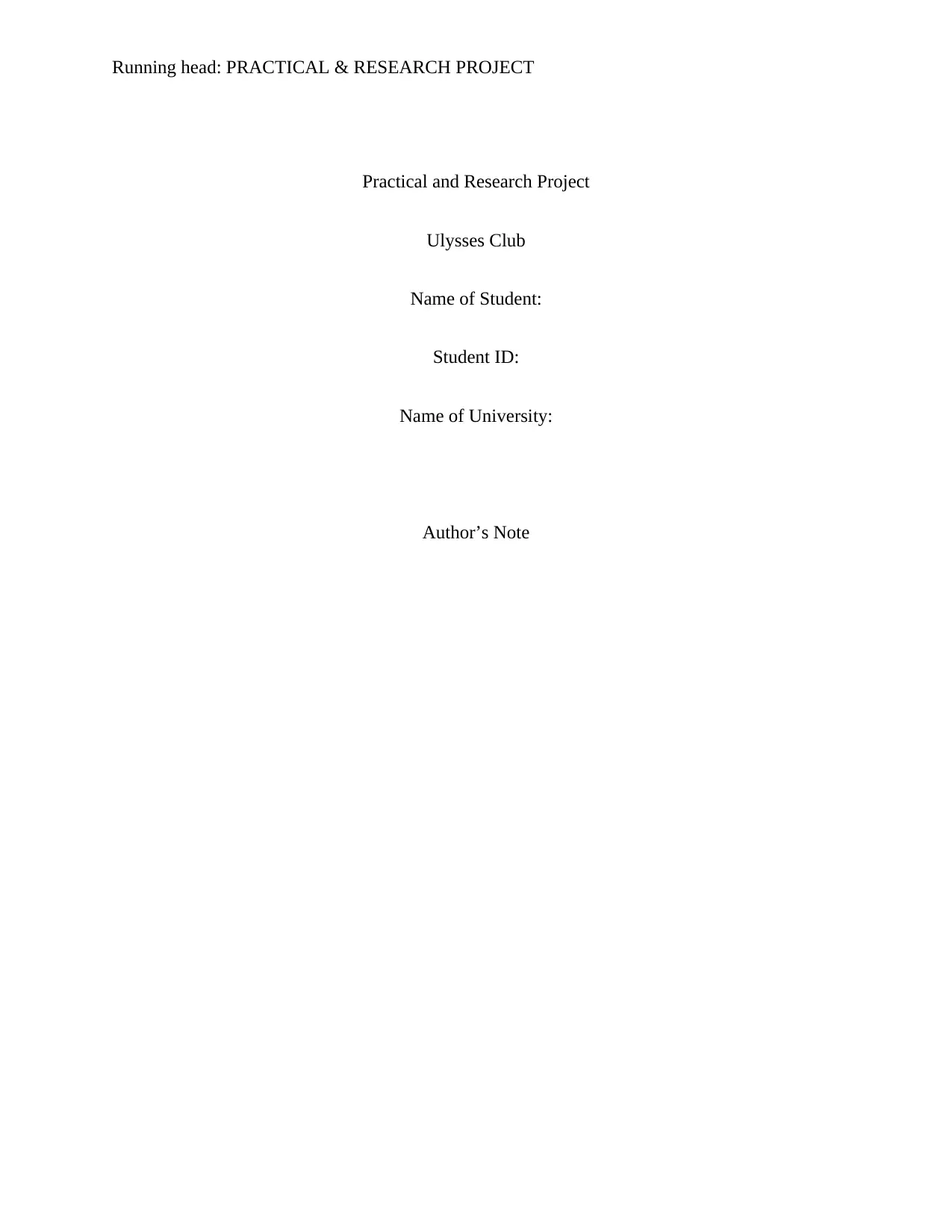
Running head: PRACTICAL & RESEARCH PROJECT
Practical and Research Project
Ulysses Club
Name of Student:
Student ID:
Name of University:
Author’s Note
Practical and Research Project
Ulysses Club
Name of Student:
Student ID:
Name of University:
Author’s Note
Paraphrase This Document
Need a fresh take? Get an instant paraphrase of this document with our AI Paraphraser
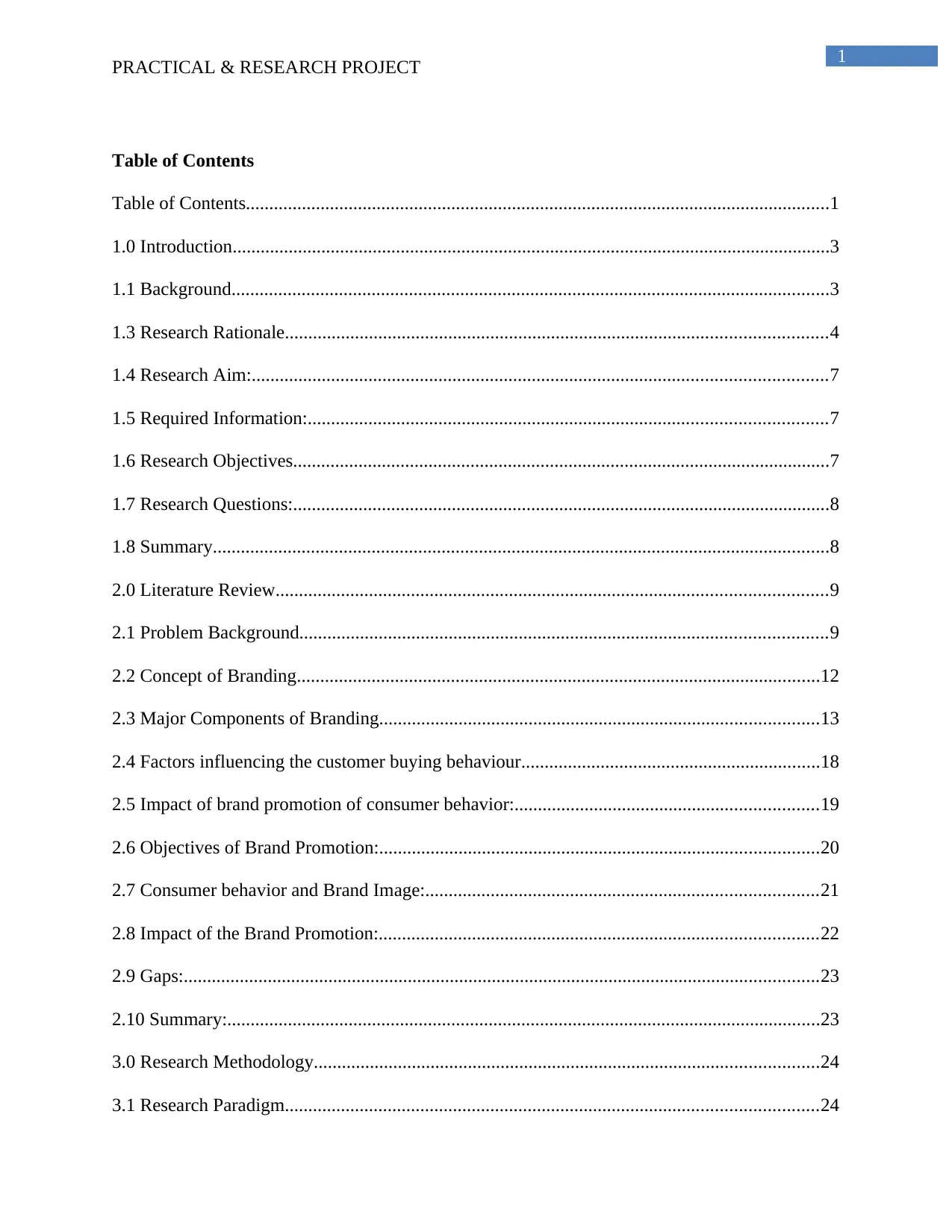
1
PRACTICAL & RESEARCH PROJECT
Table of Contents
Table of Contents.............................................................................................................................1
1.0 Introduction................................................................................................................................3
1.1 Background................................................................................................................................3
1.3 Research Rationale....................................................................................................................4
1.4 Research Aim:...........................................................................................................................7
1.5 Required Information:...............................................................................................................7
1.6 Research Objectives...................................................................................................................7
1.7 Research Questions:...................................................................................................................8
1.8 Summary....................................................................................................................................8
2.0 Literature Review......................................................................................................................9
2.1 Problem Background.................................................................................................................9
2.2 Concept of Branding................................................................................................................12
2.3 Major Components of Branding..............................................................................................13
2.4 Factors influencing the customer buying behaviour................................................................18
2.5 Impact of brand promotion of consumer behavior:.................................................................19
2.6 Objectives of Brand Promotion:..............................................................................................20
2.7 Consumer behavior and Brand Image:....................................................................................21
2.8 Impact of the Brand Promotion:..............................................................................................22
2.9 Gaps:........................................................................................................................................23
2.10 Summary:...............................................................................................................................23
3.0 Research Methodology............................................................................................................24
3.1 Research Paradigm..................................................................................................................24
PRACTICAL & RESEARCH PROJECT
Table of Contents
Table of Contents.............................................................................................................................1
1.0 Introduction................................................................................................................................3
1.1 Background................................................................................................................................3
1.3 Research Rationale....................................................................................................................4
1.4 Research Aim:...........................................................................................................................7
1.5 Required Information:...............................................................................................................7
1.6 Research Objectives...................................................................................................................7
1.7 Research Questions:...................................................................................................................8
1.8 Summary....................................................................................................................................8
2.0 Literature Review......................................................................................................................9
2.1 Problem Background.................................................................................................................9
2.2 Concept of Branding................................................................................................................12
2.3 Major Components of Branding..............................................................................................13
2.4 Factors influencing the customer buying behaviour................................................................18
2.5 Impact of brand promotion of consumer behavior:.................................................................19
2.6 Objectives of Brand Promotion:..............................................................................................20
2.7 Consumer behavior and Brand Image:....................................................................................21
2.8 Impact of the Brand Promotion:..............................................................................................22
2.9 Gaps:........................................................................................................................................23
2.10 Summary:...............................................................................................................................23
3.0 Research Methodology............................................................................................................24
3.1 Research Paradigm..................................................................................................................24
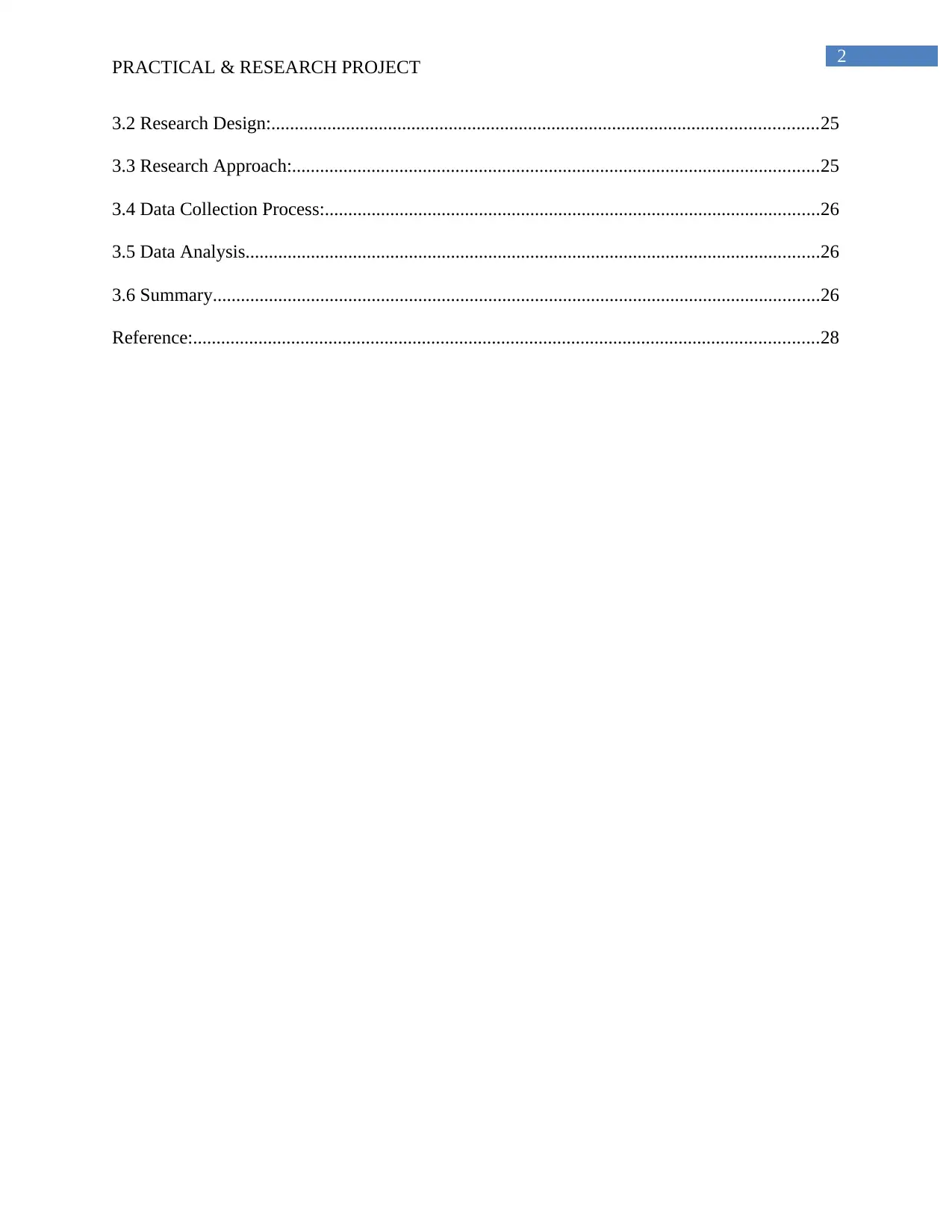
2
PRACTICAL & RESEARCH PROJECT
3.2 Research Design:.....................................................................................................................25
3.3 Research Approach:.................................................................................................................25
3.4 Data Collection Process:..........................................................................................................26
3.5 Data Analysis...........................................................................................................................26
3.6 Summary..................................................................................................................................26
Reference:......................................................................................................................................28
PRACTICAL & RESEARCH PROJECT
3.2 Research Design:.....................................................................................................................25
3.3 Research Approach:.................................................................................................................25
3.4 Data Collection Process:..........................................................................................................26
3.5 Data Analysis...........................................................................................................................26
3.6 Summary..................................................................................................................................26
Reference:......................................................................................................................................28
⊘ This is a preview!⊘
Do you want full access?
Subscribe today to unlock all pages.

Trusted by 1+ million students worldwide
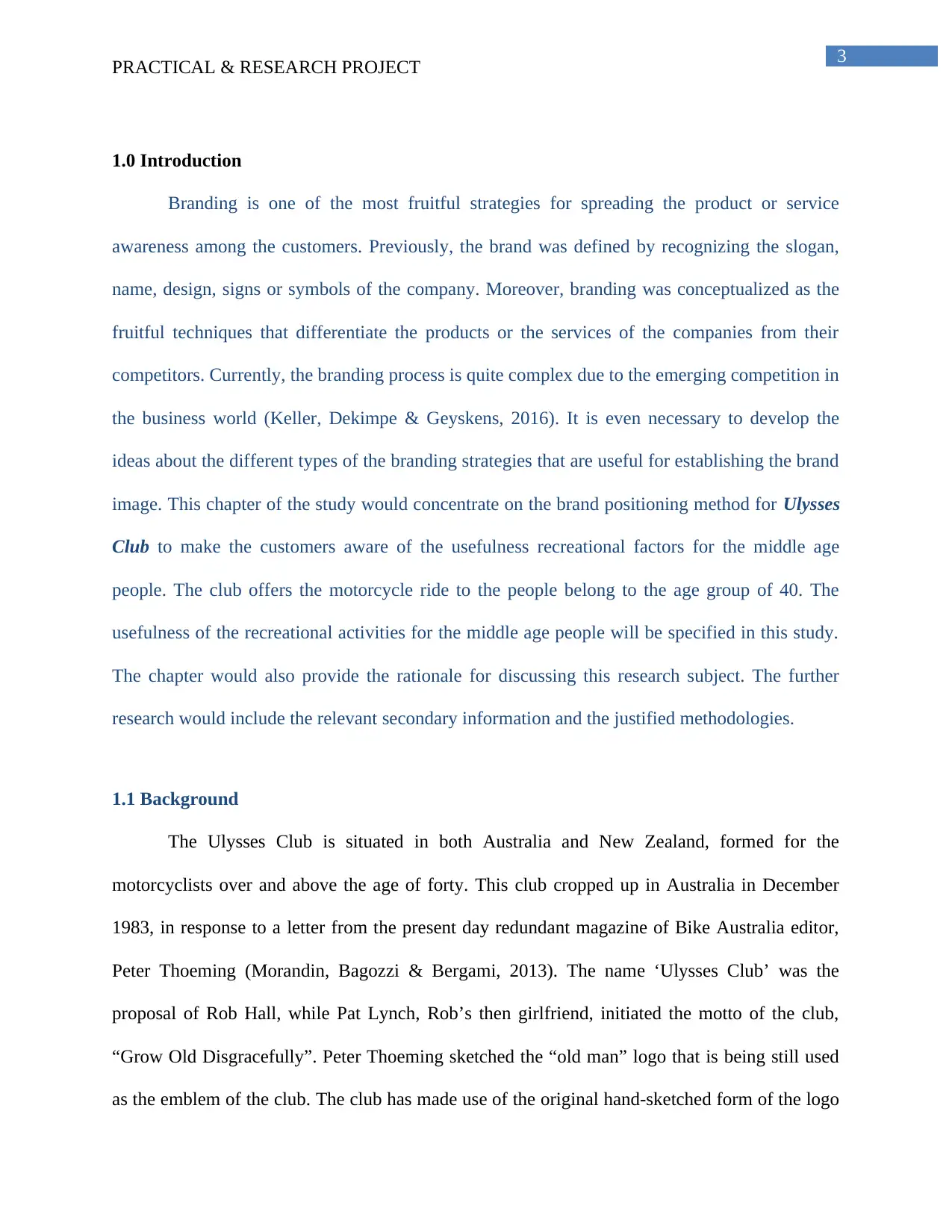
3
PRACTICAL & RESEARCH PROJECT
1.0 Introduction
Branding is one of the most fruitful strategies for spreading the product or service
awareness among the customers. Previously, the brand was defined by recognizing the slogan,
name, design, signs or symbols of the company. Moreover, branding was conceptualized as the
fruitful techniques that differentiate the products or the services of the companies from their
competitors. Currently, the branding process is quite complex due to the emerging competition in
the business world (Keller, Dekimpe & Geyskens, 2016). It is even necessary to develop the
ideas about the different types of the branding strategies that are useful for establishing the brand
image. This chapter of the study would concentrate on the brand positioning method for Ulysses
Club to make the customers aware of the usefulness recreational factors for the middle age
people. The club offers the motorcycle ride to the people belong to the age group of 40. The
usefulness of the recreational activities for the middle age people will be specified in this study.
The chapter would also provide the rationale for discussing this research subject. The further
research would include the relevant secondary information and the justified methodologies.
1.1 Background
The Ulysses Club is situated in both Australia and New Zealand, formed for the
motorcyclists over and above the age of forty. This club cropped up in Australia in December
1983, in response to a letter from the present day redundant magazine of Bike Australia editor,
Peter Thoeming (Morandin, Bagozzi & Bergami, 2013). The name ‘Ulysses Club’ was the
proposal of Rob Hall, while Pat Lynch, Rob’s then girlfriend, initiated the motto of the club,
“Grow Old Disgracefully”. Peter Thoeming sketched the “old man” logo that is being still used
as the emblem of the club. The club has made use of the original hand-sketched form of the logo
PRACTICAL & RESEARCH PROJECT
1.0 Introduction
Branding is one of the most fruitful strategies for spreading the product or service
awareness among the customers. Previously, the brand was defined by recognizing the slogan,
name, design, signs or symbols of the company. Moreover, branding was conceptualized as the
fruitful techniques that differentiate the products or the services of the companies from their
competitors. Currently, the branding process is quite complex due to the emerging competition in
the business world (Keller, Dekimpe & Geyskens, 2016). It is even necessary to develop the
ideas about the different types of the branding strategies that are useful for establishing the brand
image. This chapter of the study would concentrate on the brand positioning method for Ulysses
Club to make the customers aware of the usefulness recreational factors for the middle age
people. The club offers the motorcycle ride to the people belong to the age group of 40. The
usefulness of the recreational activities for the middle age people will be specified in this study.
The chapter would also provide the rationale for discussing this research subject. The further
research would include the relevant secondary information and the justified methodologies.
1.1 Background
The Ulysses Club is situated in both Australia and New Zealand, formed for the
motorcyclists over and above the age of forty. This club cropped up in Australia in December
1983, in response to a letter from the present day redundant magazine of Bike Australia editor,
Peter Thoeming (Morandin, Bagozzi & Bergami, 2013). The name ‘Ulysses Club’ was the
proposal of Rob Hall, while Pat Lynch, Rob’s then girlfriend, initiated the motto of the club,
“Grow Old Disgracefully”. Peter Thoeming sketched the “old man” logo that is being still used
as the emblem of the club. The club has made use of the original hand-sketched form of the logo
Paraphrase This Document
Need a fresh take? Get an instant paraphrase of this document with our AI Paraphraser
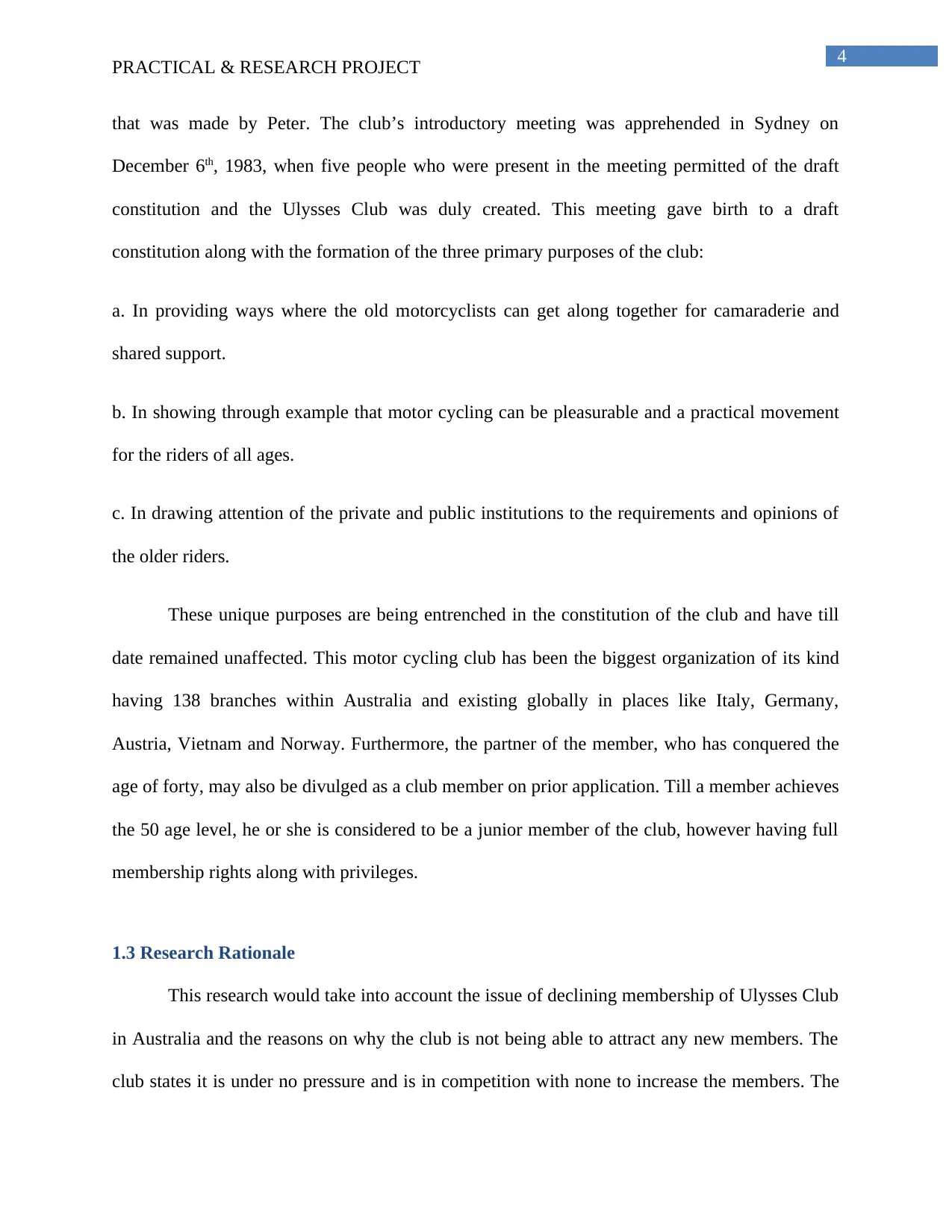
4
PRACTICAL & RESEARCH PROJECT
that was made by Peter. The club’s introductory meeting was apprehended in Sydney on
December 6th, 1983, when five people who were present in the meeting permitted of the draft
constitution and the Ulysses Club was duly created. This meeting gave birth to a draft
constitution along with the formation of the three primary purposes of the club:
a. In providing ways where the old motorcyclists can get along together for camaraderie and
shared support.
b. In showing through example that motor cycling can be pleasurable and a practical movement
for the riders of all ages.
c. In drawing attention of the private and public institutions to the requirements and opinions of
the older riders.
These unique purposes are being entrenched in the constitution of the club and have till
date remained unaffected. This motor cycling club has been the biggest organization of its kind
having 138 branches within Australia and existing globally in places like Italy, Germany,
Austria, Vietnam and Norway. Furthermore, the partner of the member, who has conquered the
age of forty, may also be divulged as a club member on prior application. Till a member achieves
the 50 age level, he or she is considered to be a junior member of the club, however having full
membership rights along with privileges.
1.3 Research Rationale
This research would take into account the issue of declining membership of Ulysses Club
in Australia and the reasons on why the club is not being able to attract any new members. The
club states it is under no pressure and is in competition with none to increase the members. The
PRACTICAL & RESEARCH PROJECT
that was made by Peter. The club’s introductory meeting was apprehended in Sydney on
December 6th, 1983, when five people who were present in the meeting permitted of the draft
constitution and the Ulysses Club was duly created. This meeting gave birth to a draft
constitution along with the formation of the three primary purposes of the club:
a. In providing ways where the old motorcyclists can get along together for camaraderie and
shared support.
b. In showing through example that motor cycling can be pleasurable and a practical movement
for the riders of all ages.
c. In drawing attention of the private and public institutions to the requirements and opinions of
the older riders.
These unique purposes are being entrenched in the constitution of the club and have till
date remained unaffected. This motor cycling club has been the biggest organization of its kind
having 138 branches within Australia and existing globally in places like Italy, Germany,
Austria, Vietnam and Norway. Furthermore, the partner of the member, who has conquered the
age of forty, may also be divulged as a club member on prior application. Till a member achieves
the 50 age level, he or she is considered to be a junior member of the club, however having full
membership rights along with privileges.
1.3 Research Rationale
This research would take into account the issue of declining membership of Ulysses Club
in Australia and the reasons on why the club is not being able to attract any new members. The
club states it is under no pressure and is in competition with none to increase the members. The
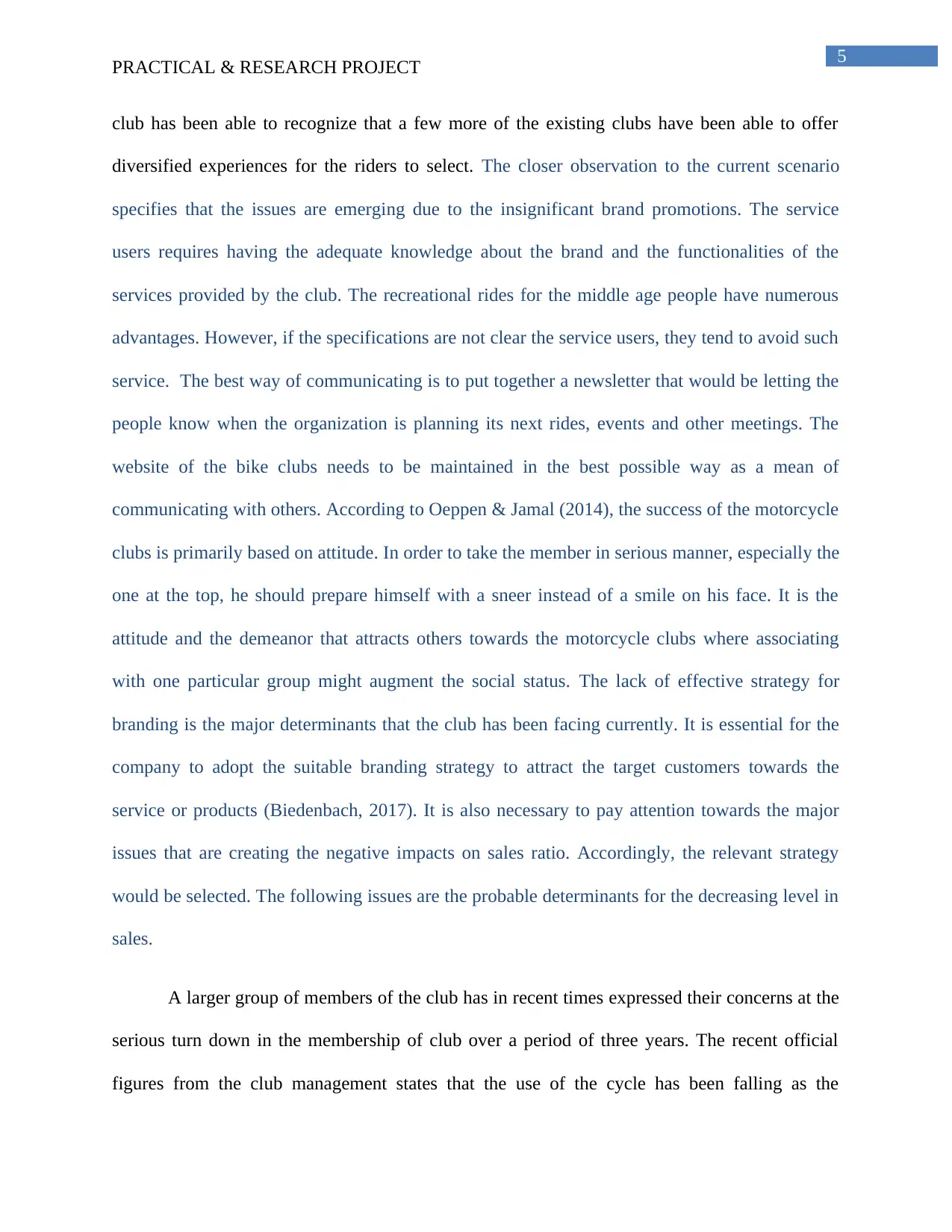
5
PRACTICAL & RESEARCH PROJECT
club has been able to recognize that a few more of the existing clubs have been able to offer
diversified experiences for the riders to select. The closer observation to the current scenario
specifies that the issues are emerging due to the insignificant brand promotions. The service
users requires having the adequate knowledge about the brand and the functionalities of the
services provided by the club. The recreational rides for the middle age people have numerous
advantages. However, if the specifications are not clear the service users, they tend to avoid such
service. The best way of communicating is to put together a newsletter that would be letting the
people know when the organization is planning its next rides, events and other meetings. The
website of the bike clubs needs to be maintained in the best possible way as a mean of
communicating with others. According to Oeppen & Jamal (2014), the success of the motorcycle
clubs is primarily based on attitude. In order to take the member in serious manner, especially the
one at the top, he should prepare himself with a sneer instead of a smile on his face. It is the
attitude and the demeanor that attracts others towards the motorcycle clubs where associating
with one particular group might augment the social status. The lack of effective strategy for
branding is the major determinants that the club has been facing currently. It is essential for the
company to adopt the suitable branding strategy to attract the target customers towards the
service or products (Biedenbach, 2017). It is also necessary to pay attention towards the major
issues that are creating the negative impacts on sales ratio. Accordingly, the relevant strategy
would be selected. The following issues are the probable determinants for the decreasing level in
sales.
A larger group of members of the club has in recent times expressed their concerns at the
serious turn down in the membership of club over a period of three years. The recent official
figures from the club management states that the use of the cycle has been falling as the
PRACTICAL & RESEARCH PROJECT
club has been able to recognize that a few more of the existing clubs have been able to offer
diversified experiences for the riders to select. The closer observation to the current scenario
specifies that the issues are emerging due to the insignificant brand promotions. The service
users requires having the adequate knowledge about the brand and the functionalities of the
services provided by the club. The recreational rides for the middle age people have numerous
advantages. However, if the specifications are not clear the service users, they tend to avoid such
service. The best way of communicating is to put together a newsletter that would be letting the
people know when the organization is planning its next rides, events and other meetings. The
website of the bike clubs needs to be maintained in the best possible way as a mean of
communicating with others. According to Oeppen & Jamal (2014), the success of the motorcycle
clubs is primarily based on attitude. In order to take the member in serious manner, especially the
one at the top, he should prepare himself with a sneer instead of a smile on his face. It is the
attitude and the demeanor that attracts others towards the motorcycle clubs where associating
with one particular group might augment the social status. The lack of effective strategy for
branding is the major determinants that the club has been facing currently. It is essential for the
company to adopt the suitable branding strategy to attract the target customers towards the
service or products (Biedenbach, 2017). It is also necessary to pay attention towards the major
issues that are creating the negative impacts on sales ratio. Accordingly, the relevant strategy
would be selected. The following issues are the probable determinants for the decreasing level in
sales.
A larger group of members of the club has in recent times expressed their concerns at the
serious turn down in the membership of club over a period of three years. The recent official
figures from the club management states that the use of the cycle has been falling as the
⊘ This is a preview!⊘
Do you want full access?
Subscribe today to unlock all pages.

Trusted by 1+ million students worldwide
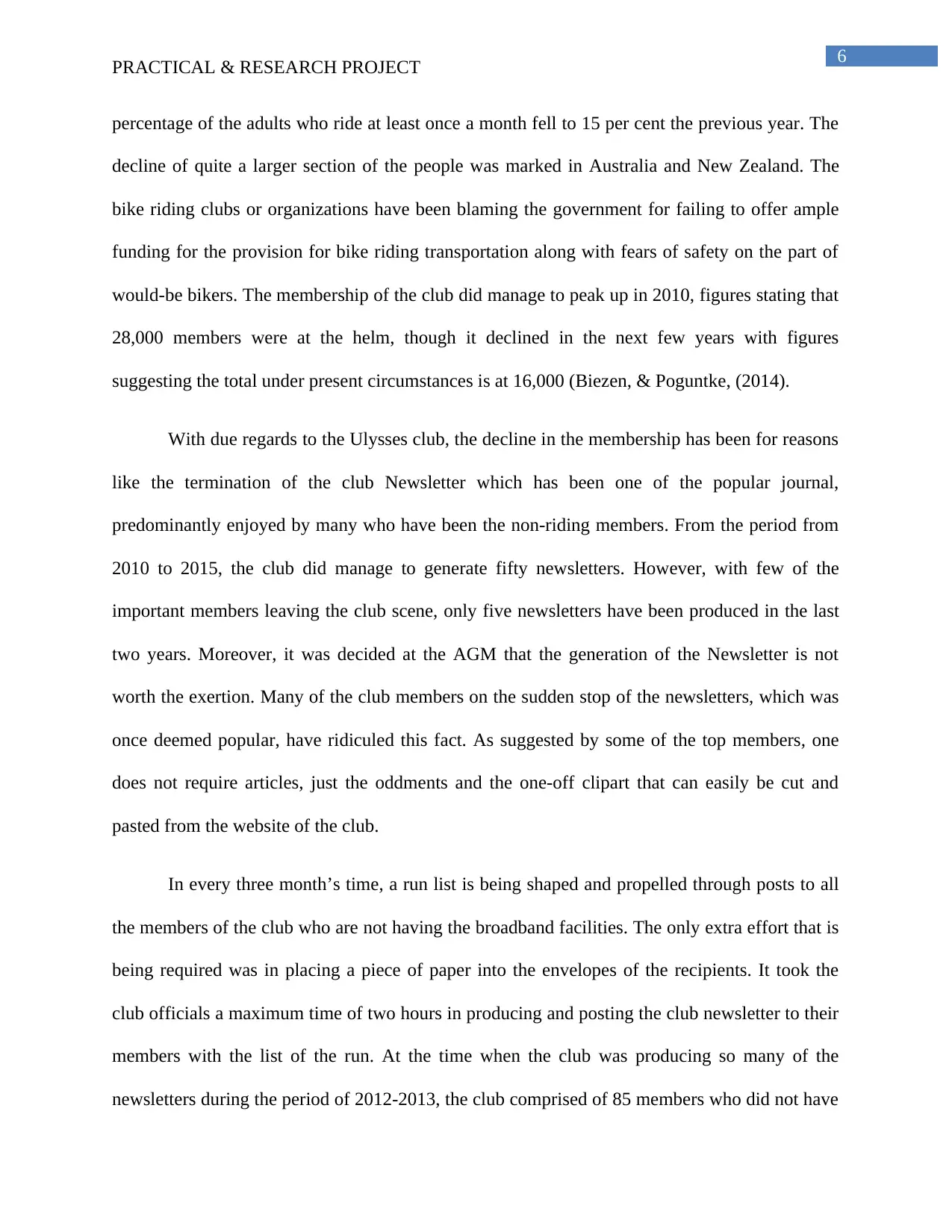
6
PRACTICAL & RESEARCH PROJECT
percentage of the adults who ride at least once a month fell to 15 per cent the previous year. The
decline of quite a larger section of the people was marked in Australia and New Zealand. The
bike riding clubs or organizations have been blaming the government for failing to offer ample
funding for the provision for bike riding transportation along with fears of safety on the part of
would-be bikers. The membership of the club did manage to peak up in 2010, figures stating that
28,000 members were at the helm, though it declined in the next few years with figures
suggesting the total under present circumstances is at 16,000 (Biezen, & Poguntke, (2014).
With due regards to the Ulysses club, the decline in the membership has been for reasons
like the termination of the club Newsletter which has been one of the popular journal,
predominantly enjoyed by many who have been the non-riding members. From the period from
2010 to 2015, the club did manage to generate fifty newsletters. However, with few of the
important members leaving the club scene, only five newsletters have been produced in the last
two years. Moreover, it was decided at the AGM that the generation of the Newsletter is not
worth the exertion. Many of the club members on the sudden stop of the newsletters, which was
once deemed popular, have ridiculed this fact. As suggested by some of the top members, one
does not require articles, just the oddments and the one-off clipart that can easily be cut and
pasted from the website of the club.
In every three month’s time, a run list is being shaped and propelled through posts to all
the members of the club who are not having the broadband facilities. The only extra effort that is
being required was in placing a piece of paper into the envelopes of the recipients. It took the
club officials a maximum time of two hours in producing and posting the club newsletter to their
members with the list of the run. At the time when the club was producing so many of the
newsletters during the period of 2012-2013, the club comprised of 85 members who did not have
PRACTICAL & RESEARCH PROJECT
percentage of the adults who ride at least once a month fell to 15 per cent the previous year. The
decline of quite a larger section of the people was marked in Australia and New Zealand. The
bike riding clubs or organizations have been blaming the government for failing to offer ample
funding for the provision for bike riding transportation along with fears of safety on the part of
would-be bikers. The membership of the club did manage to peak up in 2010, figures stating that
28,000 members were at the helm, though it declined in the next few years with figures
suggesting the total under present circumstances is at 16,000 (Biezen, & Poguntke, (2014).
With due regards to the Ulysses club, the decline in the membership has been for reasons
like the termination of the club Newsletter which has been one of the popular journal,
predominantly enjoyed by many who have been the non-riding members. From the period from
2010 to 2015, the club did manage to generate fifty newsletters. However, with few of the
important members leaving the club scene, only five newsletters have been produced in the last
two years. Moreover, it was decided at the AGM that the generation of the Newsletter is not
worth the exertion. Many of the club members on the sudden stop of the newsletters, which was
once deemed popular, have ridiculed this fact. As suggested by some of the top members, one
does not require articles, just the oddments and the one-off clipart that can easily be cut and
pasted from the website of the club.
In every three month’s time, a run list is being shaped and propelled through posts to all
the members of the club who are not having the broadband facilities. The only extra effort that is
being required was in placing a piece of paper into the envelopes of the recipients. It took the
club officials a maximum time of two hours in producing and posting the club newsletter to their
members with the list of the run. At the time when the club was producing so many of the
newsletters during the period of 2012-2013, the club comprised of 85 members who did not have
Paraphrase This Document
Need a fresh take? Get an instant paraphrase of this document with our AI Paraphraser
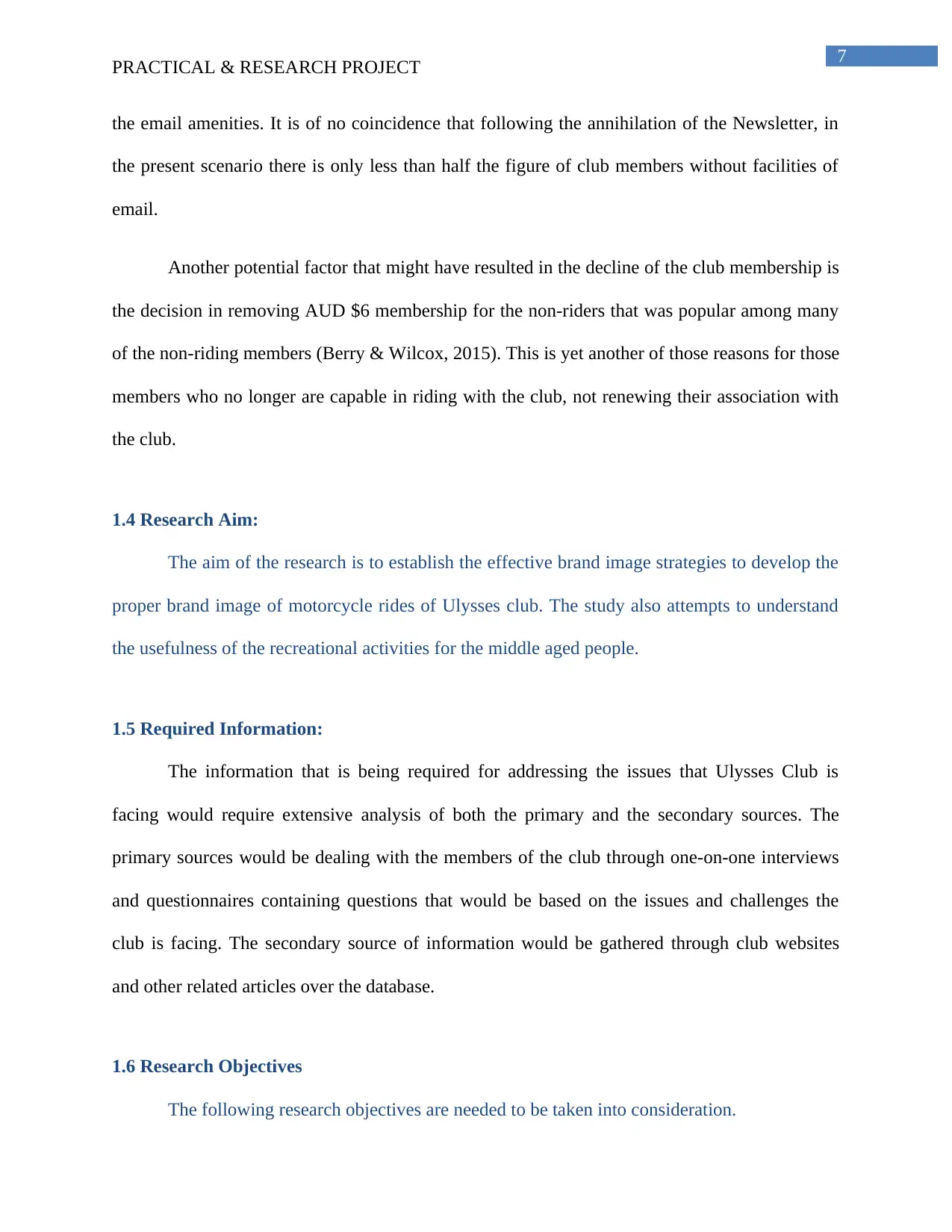
7
PRACTICAL & RESEARCH PROJECT
the email amenities. It is of no coincidence that following the annihilation of the Newsletter, in
the present scenario there is only less than half the figure of club members without facilities of
email.
Another potential factor that might have resulted in the decline of the club membership is
the decision in removing AUD $6 membership for the non-riders that was popular among many
of the non-riding members (Berry & Wilcox, 2015). This is yet another of those reasons for those
members who no longer are capable in riding with the club, not renewing their association with
the club.
1.4 Research Aim:
The aim of the research is to establish the effective brand image strategies to develop the
proper brand image of motorcycle rides of Ulysses club. The study also attempts to understand
the usefulness of the recreational activities for the middle aged people.
1.5 Required Information:
The information that is being required for addressing the issues that Ulysses Club is
facing would require extensive analysis of both the primary and the secondary sources. The
primary sources would be dealing with the members of the club through one-on-one interviews
and questionnaires containing questions that would be based on the issues and challenges the
club is facing. The secondary source of information would be gathered through club websites
and other related articles over the database.
1.6 Research Objectives
The following research objectives are needed to be taken into consideration.
PRACTICAL & RESEARCH PROJECT
the email amenities. It is of no coincidence that following the annihilation of the Newsletter, in
the present scenario there is only less than half the figure of club members without facilities of
email.
Another potential factor that might have resulted in the decline of the club membership is
the decision in removing AUD $6 membership for the non-riders that was popular among many
of the non-riding members (Berry & Wilcox, 2015). This is yet another of those reasons for those
members who no longer are capable in riding with the club, not renewing their association with
the club.
1.4 Research Aim:
The aim of the research is to establish the effective brand image strategies to develop the
proper brand image of motorcycle rides of Ulysses club. The study also attempts to understand
the usefulness of the recreational activities for the middle aged people.
1.5 Required Information:
The information that is being required for addressing the issues that Ulysses Club is
facing would require extensive analysis of both the primary and the secondary sources. The
primary sources would be dealing with the members of the club through one-on-one interviews
and questionnaires containing questions that would be based on the issues and challenges the
club is facing. The secondary source of information would be gathered through club websites
and other related articles over the database.
1.6 Research Objectives
The following research objectives are needed to be taken into consideration.
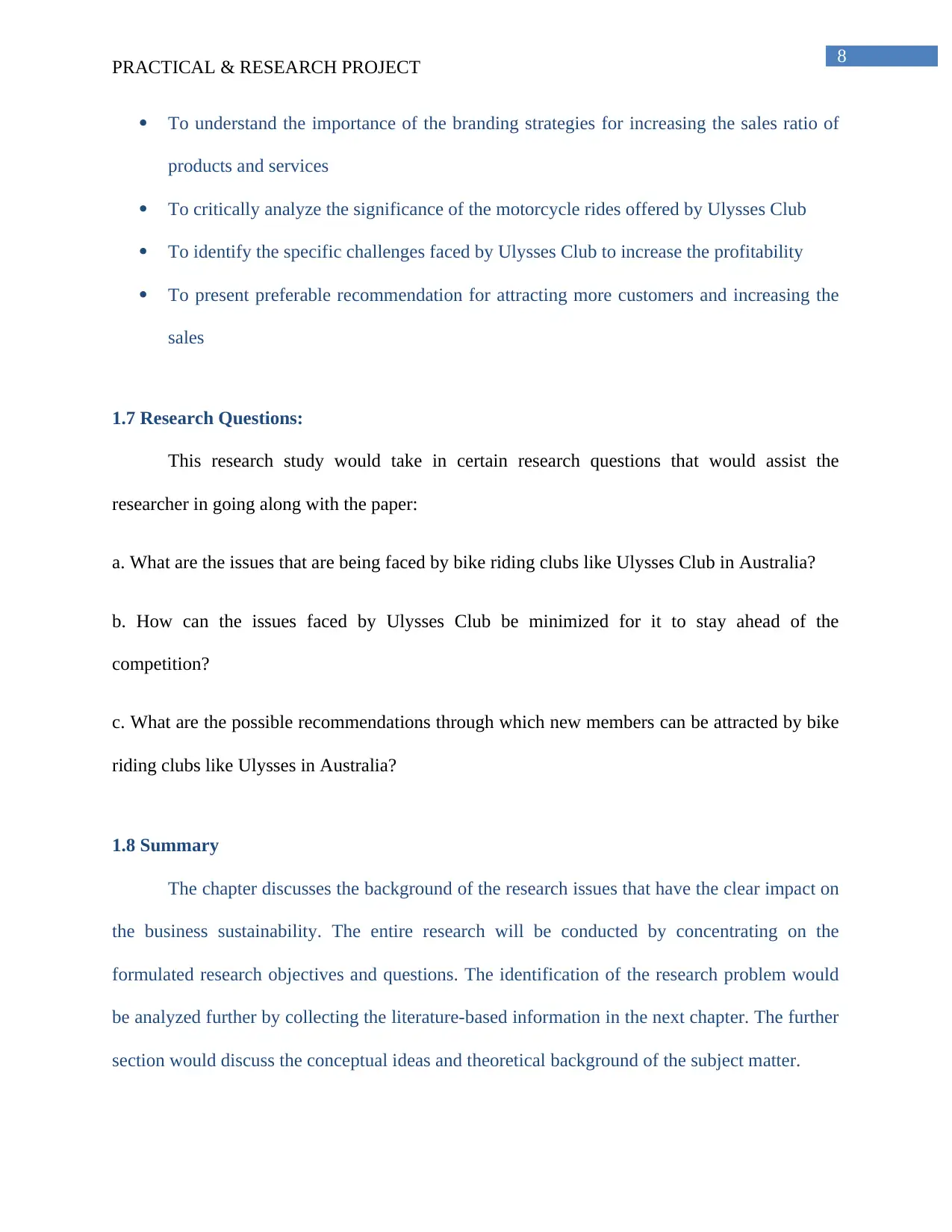
8
PRACTICAL & RESEARCH PROJECT
To understand the importance of the branding strategies for increasing the sales ratio of
products and services
To critically analyze the significance of the motorcycle rides offered by Ulysses Club
To identify the specific challenges faced by Ulysses Club to increase the profitability
To present preferable recommendation for attracting more customers and increasing the
sales
1.7 Research Questions:
This research study would take in certain research questions that would assist the
researcher in going along with the paper:
a. What are the issues that are being faced by bike riding clubs like Ulysses Club in Australia?
b. How can the issues faced by Ulysses Club be minimized for it to stay ahead of the
competition?
c. What are the possible recommendations through which new members can be attracted by bike
riding clubs like Ulysses in Australia?
1.8 Summary
The chapter discusses the background of the research issues that have the clear impact on
the business sustainability. The entire research will be conducted by concentrating on the
formulated research objectives and questions. The identification of the research problem would
be analyzed further by collecting the literature-based information in the next chapter. The further
section would discuss the conceptual ideas and theoretical background of the subject matter.
PRACTICAL & RESEARCH PROJECT
To understand the importance of the branding strategies for increasing the sales ratio of
products and services
To critically analyze the significance of the motorcycle rides offered by Ulysses Club
To identify the specific challenges faced by Ulysses Club to increase the profitability
To present preferable recommendation for attracting more customers and increasing the
sales
1.7 Research Questions:
This research study would take in certain research questions that would assist the
researcher in going along with the paper:
a. What are the issues that are being faced by bike riding clubs like Ulysses Club in Australia?
b. How can the issues faced by Ulysses Club be minimized for it to stay ahead of the
competition?
c. What are the possible recommendations through which new members can be attracted by bike
riding clubs like Ulysses in Australia?
1.8 Summary
The chapter discusses the background of the research issues that have the clear impact on
the business sustainability. The entire research will be conducted by concentrating on the
formulated research objectives and questions. The identification of the research problem would
be analyzed further by collecting the literature-based information in the next chapter. The further
section would discuss the conceptual ideas and theoretical background of the subject matter.
⊘ This is a preview!⊘
Do you want full access?
Subscribe today to unlock all pages.

Trusted by 1+ million students worldwide
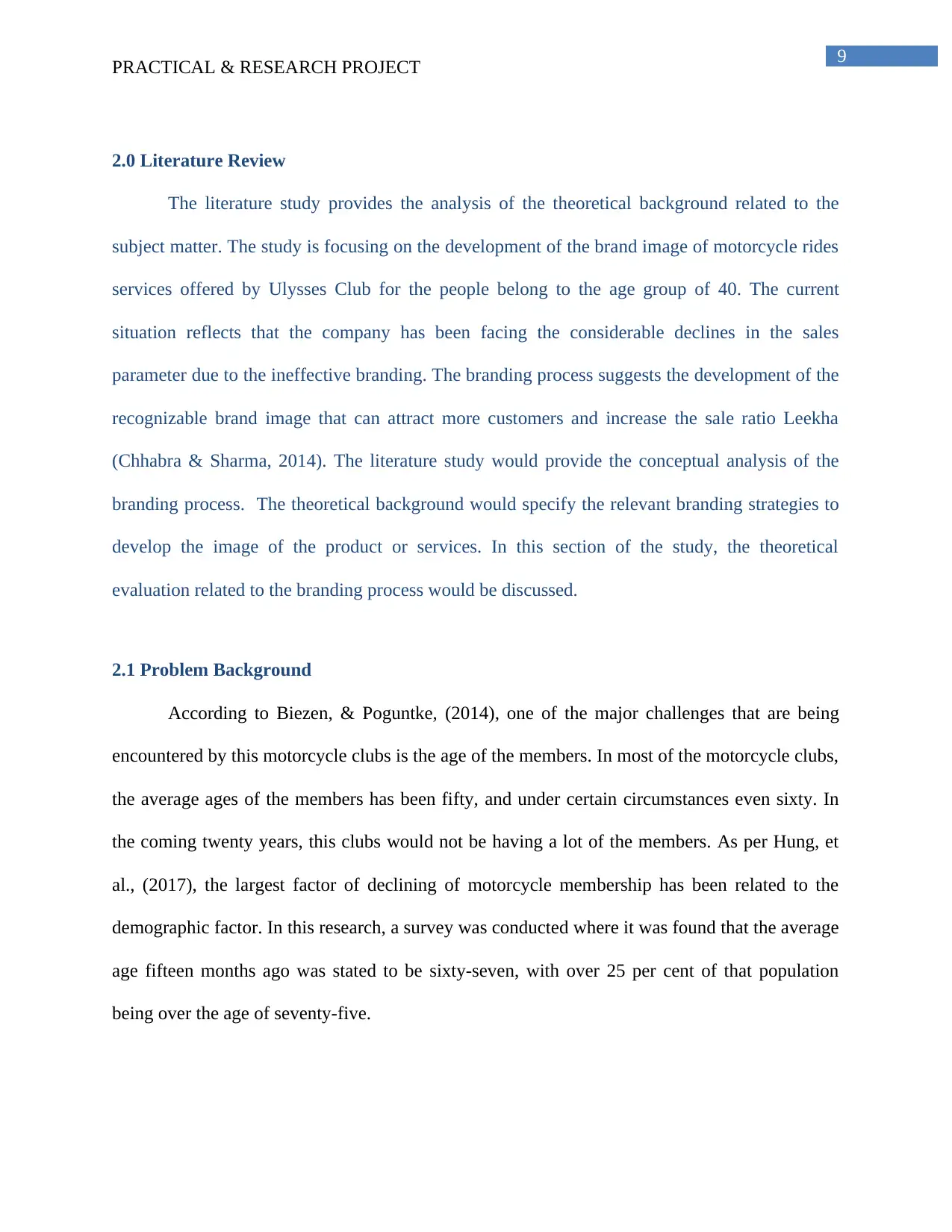
9
PRACTICAL & RESEARCH PROJECT
2.0 Literature Review
The literature study provides the analysis of the theoretical background related to the
subject matter. The study is focusing on the development of the brand image of motorcycle rides
services offered by Ulysses Club for the people belong to the age group of 40. The current
situation reflects that the company has been facing the considerable declines in the sales
parameter due to the ineffective branding. The branding process suggests the development of the
recognizable brand image that can attract more customers and increase the sale ratio Leekha
(Chhabra & Sharma, 2014). The literature study would provide the conceptual analysis of the
branding process. The theoretical background would specify the relevant branding strategies to
develop the image of the product or services. In this section of the study, the theoretical
evaluation related to the branding process would be discussed.
2.1 Problem Background
According to Biezen, & Poguntke, (2014), one of the major challenges that are being
encountered by this motorcycle clubs is the age of the members. In most of the motorcycle clubs,
the average ages of the members has been fifty, and under certain circumstances even sixty. In
the coming twenty years, this clubs would not be having a lot of the members. As per Hung, et
al., (2017), the largest factor of declining of motorcycle membership has been related to the
demographic factor. In this research, a survey was conducted where it was found that the average
age fifteen months ago was stated to be sixty-seven, with over 25 per cent of that population
being over the age of seventy-five.
PRACTICAL & RESEARCH PROJECT
2.0 Literature Review
The literature study provides the analysis of the theoretical background related to the
subject matter. The study is focusing on the development of the brand image of motorcycle rides
services offered by Ulysses Club for the people belong to the age group of 40. The current
situation reflects that the company has been facing the considerable declines in the sales
parameter due to the ineffective branding. The branding process suggests the development of the
recognizable brand image that can attract more customers and increase the sale ratio Leekha
(Chhabra & Sharma, 2014). The literature study would provide the conceptual analysis of the
branding process. The theoretical background would specify the relevant branding strategies to
develop the image of the product or services. In this section of the study, the theoretical
evaluation related to the branding process would be discussed.
2.1 Problem Background
According to Biezen, & Poguntke, (2014), one of the major challenges that are being
encountered by this motorcycle clubs is the age of the members. In most of the motorcycle clubs,
the average ages of the members has been fifty, and under certain circumstances even sixty. In
the coming twenty years, this clubs would not be having a lot of the members. As per Hung, et
al., (2017), the largest factor of declining of motorcycle membership has been related to the
demographic factor. In this research, a survey was conducted where it was found that the average
age fifteen months ago was stated to be sixty-seven, with over 25 per cent of that population
being over the age of seventy-five.
Paraphrase This Document
Need a fresh take? Get an instant paraphrase of this document with our AI Paraphraser
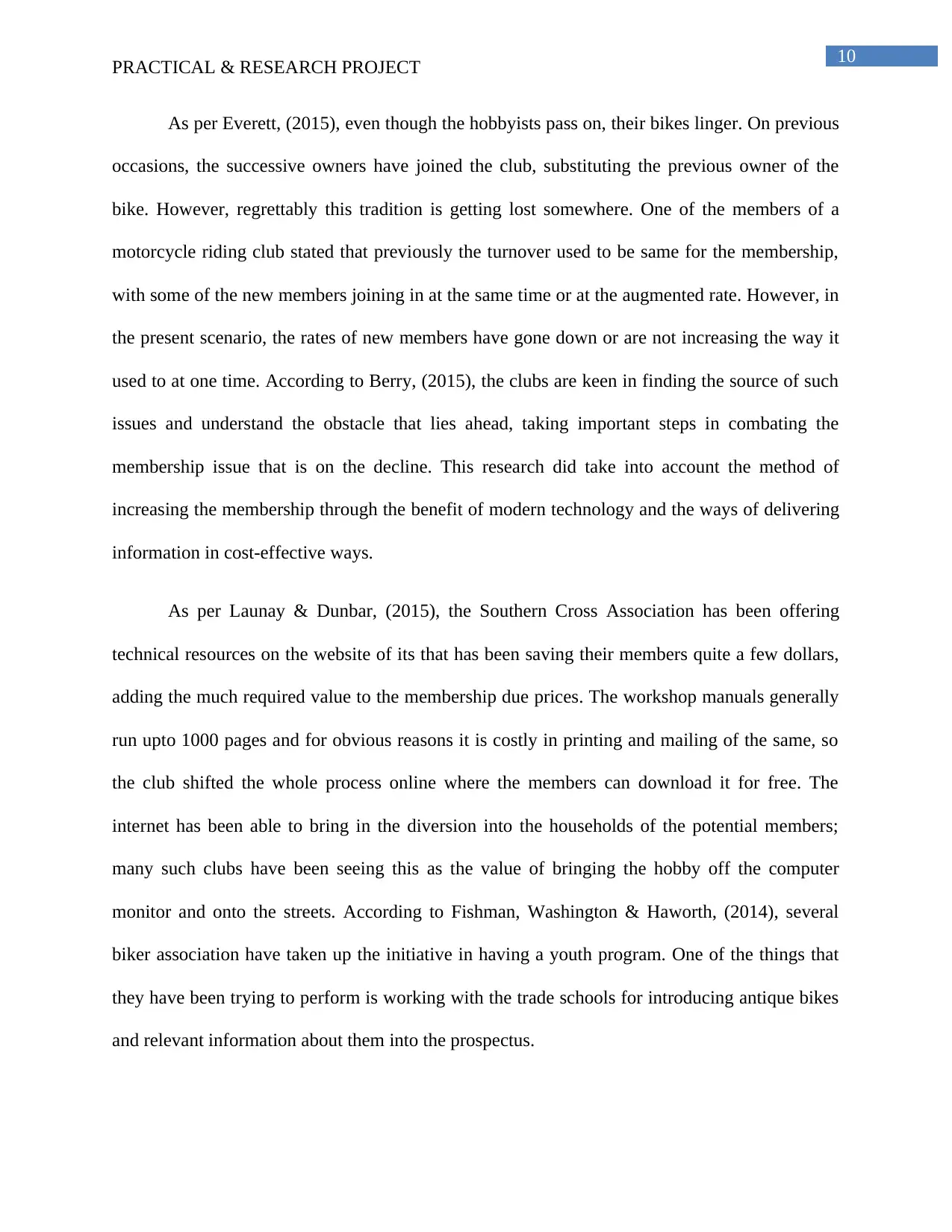
10
PRACTICAL & RESEARCH PROJECT
As per Everett, (2015), even though the hobbyists pass on, their bikes linger. On previous
occasions, the successive owners have joined the club, substituting the previous owner of the
bike. However, regrettably this tradition is getting lost somewhere. One of the members of a
motorcycle riding club stated that previously the turnover used to be same for the membership,
with some of the new members joining in at the same time or at the augmented rate. However, in
the present scenario, the rates of new members have gone down or are not increasing the way it
used to at one time. According to Berry, (2015), the clubs are keen in finding the source of such
issues and understand the obstacle that lies ahead, taking important steps in combating the
membership issue that is on the decline. This research did take into account the method of
increasing the membership through the benefit of modern technology and the ways of delivering
information in cost-effective ways.
As per Launay & Dunbar, (2015), the Southern Cross Association has been offering
technical resources on the website of its that has been saving their members quite a few dollars,
adding the much required value to the membership due prices. The workshop manuals generally
run upto 1000 pages and for obvious reasons it is costly in printing and mailing of the same, so
the club shifted the whole process online where the members can download it for free. The
internet has been able to bring in the diversion into the households of the potential members;
many such clubs have been seeing this as the value of bringing the hobby off the computer
monitor and onto the streets. According to Fishman, Washington & Haworth, (2014), several
biker association have taken up the initiative in having a youth program. One of the things that
they have been trying to perform is working with the trade schools for introducing antique bikes
and relevant information about them into the prospectus.
PRACTICAL & RESEARCH PROJECT
As per Everett, (2015), even though the hobbyists pass on, their bikes linger. On previous
occasions, the successive owners have joined the club, substituting the previous owner of the
bike. However, regrettably this tradition is getting lost somewhere. One of the members of a
motorcycle riding club stated that previously the turnover used to be same for the membership,
with some of the new members joining in at the same time or at the augmented rate. However, in
the present scenario, the rates of new members have gone down or are not increasing the way it
used to at one time. According to Berry, (2015), the clubs are keen in finding the source of such
issues and understand the obstacle that lies ahead, taking important steps in combating the
membership issue that is on the decline. This research did take into account the method of
increasing the membership through the benefit of modern technology and the ways of delivering
information in cost-effective ways.
As per Launay & Dunbar, (2015), the Southern Cross Association has been offering
technical resources on the website of its that has been saving their members quite a few dollars,
adding the much required value to the membership due prices. The workshop manuals generally
run upto 1000 pages and for obvious reasons it is costly in printing and mailing of the same, so
the club shifted the whole process online where the members can download it for free. The
internet has been able to bring in the diversion into the households of the potential members;
many such clubs have been seeing this as the value of bringing the hobby off the computer
monitor and onto the streets. According to Fishman, Washington & Haworth, (2014), several
biker association have taken up the initiative in having a youth program. One of the things that
they have been trying to perform is working with the trade schools for introducing antique bikes
and relevant information about them into the prospectus.
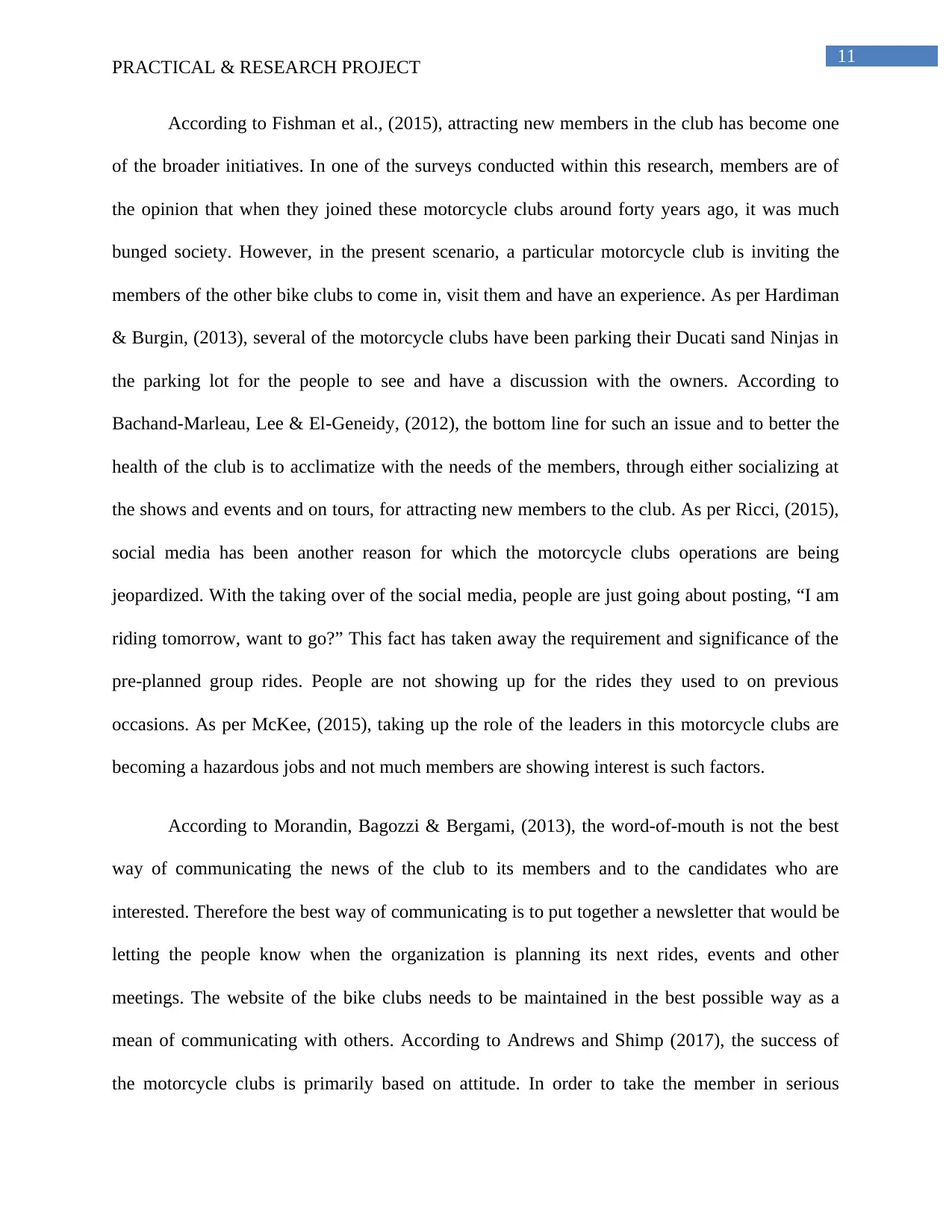
11
PRACTICAL & RESEARCH PROJECT
According to Fishman et al., (2015), attracting new members in the club has become one
of the broader initiatives. In one of the surveys conducted within this research, members are of
the opinion that when they joined these motorcycle clubs around forty years ago, it was much
bunged society. However, in the present scenario, a particular motorcycle club is inviting the
members of the other bike clubs to come in, visit them and have an experience. As per Hardiman
& Burgin, (2013), several of the motorcycle clubs have been parking their Ducati sand Ninjas in
the parking lot for the people to see and have a discussion with the owners. According to
Bachand-Marleau, Lee & El-Geneidy, (2012), the bottom line for such an issue and to better the
health of the club is to acclimatize with the needs of the members, through either socializing at
the shows and events and on tours, for attracting new members to the club. As per Ricci, (2015),
social media has been another reason for which the motorcycle clubs operations are being
jeopardized. With the taking over of the social media, people are just going about posting, “I am
riding tomorrow, want to go?” This fact has taken away the requirement and significance of the
pre-planned group rides. People are not showing up for the rides they used to on previous
occasions. As per McKee, (2015), taking up the role of the leaders in this motorcycle clubs are
becoming a hazardous jobs and not much members are showing interest is such factors.
According to Morandin, Bagozzi & Bergami, (2013), the word-of-mouth is not the best
way of communicating the news of the club to its members and to the candidates who are
interested. Therefore the best way of communicating is to put together a newsletter that would be
letting the people know when the organization is planning its next rides, events and other
meetings. The website of the bike clubs needs to be maintained in the best possible way as a
mean of communicating with others. According to Andrews and Shimp (2017), the success of
the motorcycle clubs is primarily based on attitude. In order to take the member in serious
PRACTICAL & RESEARCH PROJECT
According to Fishman et al., (2015), attracting new members in the club has become one
of the broader initiatives. In one of the surveys conducted within this research, members are of
the opinion that when they joined these motorcycle clubs around forty years ago, it was much
bunged society. However, in the present scenario, a particular motorcycle club is inviting the
members of the other bike clubs to come in, visit them and have an experience. As per Hardiman
& Burgin, (2013), several of the motorcycle clubs have been parking their Ducati sand Ninjas in
the parking lot for the people to see and have a discussion with the owners. According to
Bachand-Marleau, Lee & El-Geneidy, (2012), the bottom line for such an issue and to better the
health of the club is to acclimatize with the needs of the members, through either socializing at
the shows and events and on tours, for attracting new members to the club. As per Ricci, (2015),
social media has been another reason for which the motorcycle clubs operations are being
jeopardized. With the taking over of the social media, people are just going about posting, “I am
riding tomorrow, want to go?” This fact has taken away the requirement and significance of the
pre-planned group rides. People are not showing up for the rides they used to on previous
occasions. As per McKee, (2015), taking up the role of the leaders in this motorcycle clubs are
becoming a hazardous jobs and not much members are showing interest is such factors.
According to Morandin, Bagozzi & Bergami, (2013), the word-of-mouth is not the best
way of communicating the news of the club to its members and to the candidates who are
interested. Therefore the best way of communicating is to put together a newsletter that would be
letting the people know when the organization is planning its next rides, events and other
meetings. The website of the bike clubs needs to be maintained in the best possible way as a
mean of communicating with others. According to Andrews and Shimp (2017), the success of
the motorcycle clubs is primarily based on attitude. In order to take the member in serious
⊘ This is a preview!⊘
Do you want full access?
Subscribe today to unlock all pages.

Trusted by 1+ million students worldwide
1 out of 34
Your All-in-One AI-Powered Toolkit for Academic Success.
+13062052269
info@desklib.com
Available 24*7 on WhatsApp / Email
![[object Object]](/_next/static/media/star-bottom.7253800d.svg)
Unlock your academic potential
Copyright © 2020–2025 A2Z Services. All Rights Reserved. Developed and managed by ZUCOL.
